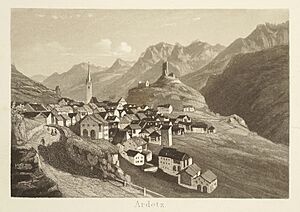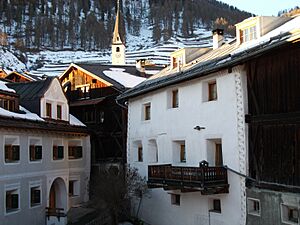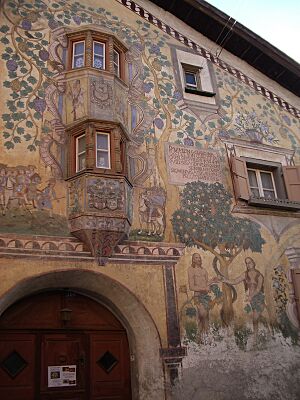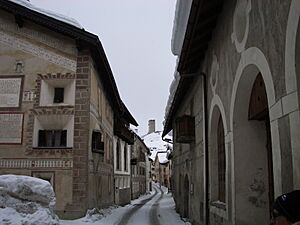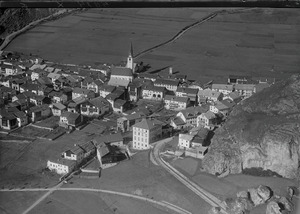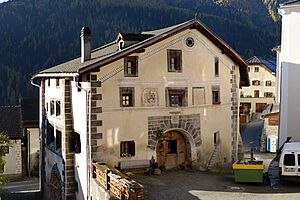Ardez facts for kids
Quick facts for kids
Ardez
|
||
|---|---|---|
 |
||
|
||
| Country | Switzerland | |
| Canton | Graubünden | |
| District | Inn | |
| Area | ||
| • Total | 61.43 km2 (23.72 sq mi) | |
| Elevation | 1,467 m (4,813 ft) | |
| Population
(Dec 2014)
|
||
| • Total | 427 | |
| • Density | 6.951/km2 (18.003/sq mi) | |
| Postal code |
7546
|
|
| Surrounded by | Ftan, Galtür (Austria), Guarda, Lavin, Tarasp, Zernez | |
Ardez is a former municipality in the Inn district of Graubünden, a canton in eastern Switzerland. This lovely village is found in the lower part of the Engadin valley. On January 1, 2015, Ardez joined with other villages like Guarda, Tarasp, Ftan, and Sent to form the larger municipality of Scuol.
Contents
History of Ardez
Ardez was first mentioned in old writings around the year 840. For a long time, up to the 1800s, it was also known by its German name, Steinsberg. Important families, like the Lords of Ardetz, lived here between 1161 and 1310.
Many powerful groups owned land and had rights in Ardez. These included the lords of Tarasp, the bishop of Chur, and even the county of Tyrol.
Steinsberg Castle
Steinsberg Castle, the main castle of Ardez, was bought by the bishop of Chur before 1209. Sadly, the castle and the village were destroyed in 1499 during a conflict called the Swabian War. The castle's tower has been rebuilt and repaired many times since then.
Village Life and Changes
The old church area of Ardez was quite large. It included nearby villages like Guarda, Lavin, Susch, and even Galtür in Austria. In 1538, Ardez became a Protestant village. The church was rebuilt a few decades later in 1576-1577.
In 1622, Austrian soldiers destroyed Ardez. But in 1652, the village managed to buy its freedom from Austria, which was a big deal!
The people of Ardez mostly farmed their land and raised cattle. Until the mid-1800s, they also sold wood to Tyrol. A big change happened in 1913 when the Ardez railway station opened, making travel and trade much easier.
In 1975, Ardez was chosen as one of four special "model villages" in Switzerland. This was because it had kept its old buildings and charm so well. After this, many houses in the village were carefully fixed up.
Geography of Ardez
Ardez covers an area of about 61.4 square kilometers (about 23.7 square miles). A good portion of this land, almost 30%, is used for farming. About 20% is covered by forests.
A small part of the land, less than 1%, has buildings or roads. The rest, nearly half of the area, is made up of natural features like rivers, glaciers, or mountains.
The village of Ardez is located on the left bank of the Inn River. The area also includes two smaller settlements, called hamlets, named Bos-cha and Sur En.
People of Ardez
In 2014, Ardez had a population of 427 people. About 9.8% of the people living there were from other countries in 2007. Over the ten years before that, the population grew slightly, by about 0.5%.
Age and Gender
In 2000, the population was almost evenly split between males (52%) and females (48%).
- About 12% of the population were children aged 0 to 9 years old.
- Teenagers (10 to 19 years old) made up about 11.4% of the population.
- Adults aged 20 to 59 made up about 51.7%.
- Older adults (60 to 99 years old) made up about 24.9% of the population.
Education and Jobs
Most adults in Ardez, about 70%, have completed either high school or a higher education degree from a university or a specialized college.
The unemployment rate in Ardez is quite low, around 1.08%.
- Many people work in the primary sector, which includes farming and related businesses. There were 40 people working in this area in 2005.
- The secondary sector, which involves manufacturing and construction, employed 33 people.
- The tertiary sector, which includes services like shops and tourism, employed 49 people.
Population Over Time
Here's how the population of Ardez has changed over the years:
| year | population |
|---|---|
| 1835 | 599 |
| 1900 | 612 |
| 1910 | 1,005 |
| 1950 | 541 |
| 1960 | 480 |
| 1970 | 491 |
| 1980 | 383 |
| 1990 | 393 |
| 2000 | 401 |
Languages in Ardez
The main language spoken in Ardez is Rhaeto-Romance, often called Romansh. In 2000, about 73.8% of the people spoke Romansh. The second most common language was German (20.2%), followed by Italian (3.0%).
Most people in Ardez speak the Vallader dialect of Romansh. Romansh is taught in the village school and is widely used in the community.
For a long time, Ardez was almost entirely Romansh-speaking. In 1880 and 1900, about 94% of the people spoke Romansh. This percentage slowly dropped during the 20th century, but Romansh remains the main language.
Here's a look at the languages spoken in Ardez over different years:
| Languages | Census 1980 | Census 1990 | Census 2000 | |||
|---|---|---|---|---|---|---|
| Number | Percent | Number | Percent | Number | Percent | |
| German | 50 | 13.05% | 78 | 19.85% | 81 | 20.20% |
| Romansh | 316 | 82.51% | 288 | 73.28% | 296 | 73.82% |
| Italian | 17 | 4.44% | 26 | 6.62% | 12 | 2.99% |
| Population | 383 | 100% | 393 | 100% | 401 | 100% |
Important Heritage Sites
Ardez is home to some very important historical sites. Two of them are listed as Swiss heritage sites of national significance. This means they are very special and protected.
- The Chastè (which means "castle") is one of these sites. It includes a very old prehistoric settlement, a medieval fortress, and a church.
- The Chasa dubla (meaning "Double-house") with its barn is the other important site.
The Chastè site shows signs of human settlements from the late Bronze Age and early Iron Age. There are also some interesting finds from the time of the Roman Empire.
Photo gallery Ruina chanoua at Ardez
See also
 In Spanish: Ardez para niños
In Spanish: Ardez para niños





